D&D Guide
Playing a Vampire in D&D 5e
OCT 24, 2025
Vampires have long haunted the realms of Dungeons & Dragons, weaving their dark influence through countless adventures and campaigns. Whether facing down Count Strahd von Zarovich in Curse of Strahd, delving into Ravenloft’s shadowed halls, or experimenting with vampiric subclasses and dark pacts, D&D 5e continues to evolve how players embody everyone's favorite undead icons. The allure of playing a vampire in D&D 5e lies not only in their formidable powers but also in the struggle against a cursed existence that threatens to consume their humanity. In this guide, we’ll break down exactly how to play a vampire in D&D 5e: from choosing races and classes that fit the theme, to exploring party dynamics, roleplaying tips, and other options to help bring your vampiric vision to life.
Embrace Dhampir Lore
In-game, True Vampirism is ultimately too much of a struggle to balance among a party of otherwise non-vampires. Following traditional transformation rules, the process of becoming a vampire would leave the player character drastically overpowered, creating some real potential for campaign derailment. To address this, Van Richten's Guide to Ravenloft comes with a new species known as the Dhampir. A half-vampire, half-mortal, better balanced to support a complete play-through starting from level 1. Where the vampire is a walking undead with spell-like abilities like Charm and Shapeshift, the Dhampir is born with undead traits, granted innate powers like Enhanced Speed, Spider Climb, and a Vampiric Bite attack that heals. While the Dhampir will surely provide a better plug-and-play experience compatible with other materials, the traditional vampire—the one that gets bitten and turns into bats—is still an entirely viable species type. You'll likely need to sit with your GM and talk about homebrew and general balance fixes, but don't let that discourage you from taking the night like the vampire you've always dreamed of being.
Choose the Right Species or Class
D&D 5e doesn't come with any official vampire species or class, but this tracks when you consider that the only prerequisite to be a vampire is to be afflicted by vampirism. If you're going the traditional route, your vampire can be anything or anyone. Half-orc Barbarian, Gnome Paladin, Dragonborn Sorcerer, you name it. So long as they've been bitten or otherwise had their hit points reduced to zero at the hands of a vampire, it's reasonable to assume that any creature of any race or class, if afflicted by vampirism. The same amount of freedom applies to the Dhampir alternative. Being that the Dhampir is a "lineage", you're free to roll a character whose origins are of any species of your choosing. Choosing a lineage will replace or modify your species traits, but it does not restrict your choice of species. If you're looking to choose a class that will complement the features of a vampire (or Dhampir), consider those that lean towards the arcane, the unholy, or the wicked.
Wizard: A Wizard is an obvious pick if you'd like to play an ancient and wizened spellcaster with tomes and scrolls he's collected from the corpses of countless adventurers they’ve bested over centuries past.
Sorcerer: The Sorcerer's charisma-based spellcasting works well with the vampire's seductive and charming influence. Plus, origins like Aberrant Mind in Tasha's Cauldron of Everything give you access to spells like Mind Sliver and Dissonant Whispers, or the Telepathic Speech ability for complete Vampiric mind control. Or, grab Shadow Magic from Xanathar's Guide to Everything, which gives you darkness-based abilities like increased Darkvision of 120ft and, later, Shadow Walk and Umbral Form.
Paladin: Your standard Paladin deals extra damage with their divine smites to Undead and Fiends, but the Oathbreaker Paladin flips this on its head entirely, gaining control over darkness and fear effects. A perfect fit for a vampire.
Utilize Skills Wisely
The traditional vampire is often depicted as charismatic and cunning. Being that you'll either need to coerce people into volunteering their life-essence or keep your party members off your trail while you siphon them, prioritizing skills like Deception, Persuasion, and Stealth will definitely go a long way. Vampires need to weave through social encounters effortlessly, manipulating others around them as they create divisive strategies and deploy cunning tricks and schemes.
Manage Your Blood Lust
There's no way to get around it. When we're dealing with a vampire, there's a bit of an elephant in the room. Sooner or later, you'll hunger for blood, and the only thing within reach will be your teammates. When designing your backstory, consider how your character manages their ravenous hunger for blood. If they're a hero, or at least someone with good intentions, they've probably devised a clever workaround to keep them sated. Maybe, with your table's permission, your vampire can feast on the life force of their party, being kept alive by nothing other than their goodwill. Whatever you choose, role-play your vampire's need for blood as a compelling character flaw or driving force.
Pro Tip: A fun way to balance things with your GM is to integrate feeding mechanics into your campaign, such as requiring sustenance after certain intervals or suffering penalties if your urges are ignored.
Embrace Vampiric Abilities
Lean into the potential abilities that come with being a vampire to create a full-fledged character and playstyle. If you've chosen the Dhampir lineage, make full use of features like Spider Climb for a Thief character with unique mobility, able to enter and exit encounters with ease. On the other side, make a Con-based Dhampir frontline fighter that uses their Vampiric Bite to heal themselves mid-combat, allowing them to stay on their toes with ease. You can also build a character whose abilities expand some of the typical abilities of the vampire, like a Psionics sorcerer, who uses their mental influence to gain control of an entire coven.
Build Ideas
Fighter (Rune Knight)
An excellent match for Dhampirs, with its focus on Constitution for survivability, along with runic magic that directly scales with your Con.
Build Strategy: Prioritize Strength and Con, so you can get into close quarters with the enemy and grapple them while you use your Vampiric Bite. Synergize with different Runes like the Fire Rune, which restrains foes after a hit, or the Hill Rune, which grants resistance to bludgeoning, piercing, and slashing damage.
Feats and Skills: Classic fighter feats like Great Weapon Master would definitely work well for a build like this, but prioritize feats like Resilient, which will help you stand up against common saving throw rolls. Or, increase your Athletics skill to maintain better control over your Grapple.
Combat Role: Use Giants Might at the start of the fight to gain a damage bonus, then go crazy controlling the battlefield, restraining and grappling enemies as you buff yourself with Vampiric Bite.
Warlock (Hexblade)
An excellent choice for a classic vampire build, combining dark magic with charisma and weapon mastery, for a character that naturally fits right in with traditional vampire themes.
Build Strategy: Blend melee combat with powerful eldritch magic fueled by Charisma. Plus, Hexblade features like Hexblade’s Curse provide bonus damage and vampiric-like healing when the enemy dies. Use Pact of the Blade to summon magical weapons (or flavor them as your fangs) that bypass common resistances, and fell your enemies with ease.
Feats and Skills: Pick Warcaster to maintain concentration on spells like Hex or Hold Person. Take feats like Resilient for Con boosts, and Mobile for enhanced Agility, and Deception and Persuasion to help aid that vampiric charm.
Combat Role: Begin fights by cursing targets with Hexblade’s Curse and casting Hex to increase damage output. Use the Pact Weapon and Thirsting Blade invocation to attack twice per turn, simulating rapid, fanged strikes. The Hexblade’s curse healing mimics vampiric life drain, sustaining the character through fights.
Ranger (Hunter)
A thematic and mechanically solid choice for the classic vampire turned vampire-hunter archetype.
Build Strategy: Lean into Dexterity and Constitution to maximize mobility, survivability, and enhance Vampiric Bite damage. The Ranger’s natural affinity for tracking and hunting complements the vampire’s predatory nature, and even further, the Hunter subclass gives them that blood-fueled edge. Abilities like Hunter’s Mark provide extra damage to spotted enemies, while Colossus Slayer provides bonus damage to help finish them off. Throw in a Vampiric Bite and you’ve got a full stack of extra damage.
Feats and Skills: Sharpshooter works well if you prefer ranged combat, and Resilient (Con) will help you maintain concentration while afar. Prioritize skills like Stealth and Perception for surprise attacks and ambushes, and take Survival and Athletics to better stalk your prey.
Combat Role: Act as a skilled predator, engaging in hit-and-run tactics and precision strikes. Open with Hunter’s Mark for better single-target damage, then follow up with Colossus Slayer for bonus damage on wounded enemies. Plus, the ranger’s spell selection adds tactical versatility with buffs like Hail of Thorns or control spells like Cordon of Arrows. This build offers a vampire who is both elusive and relentless, thriving in the shadows while striking down prey with deadly precision.

Aedan Hunter
Freelance copywriter and marketing multi-hyphenate. Previous experience developing marketing strategies and editing copy for small businesses and websites. Philadelphia based.